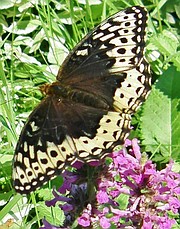Toss the poison and let Mother Nature do the work
A couple of years ago, I wrote a column regarding the dangers and negativity of pesticides in the garden. Since there are still some who automatically purchase them along with their seeds and plants, I decided to re-run it, with some additions and/or new information. In fact, you will likely see ads touting two typically vicious products — for both “bugs” and one for weeds. Please, readers, remember that it is the “bugs” that make successful gardens and landscapes, pollinating and/or controlling members of their own ilk.
Learning to live with these various minions of Mother Earth takes some understanding, a bit of self-education, and possibly some sacrifices, but learning how to attain harmony in your own little landscape is a blessing of long-standing. There’s certainly nothing natural in spraying clouds of choking poison onto plants and insects. What they kill is far beyond what you expect of them — and if you (or your child, dog or cat) get a faceful of it, a horrible headache may not be the only problem that ensues.
Once one has observed how efficient the ladybugs are at decimating aphids, how exquisitely the rather ugly caterpillar turns into a glorious — and valuable pollinating butterfly or moth, how deadly the often-maligned bats are to evening swarms of mosquitos, as well as countless other every-day landscape “miracles” from toads and garden snakes to oft-unrecognized pollinating flies and bees –an enlightenment will take place that not only changes your attitude but your whole outlook on nature.
Take the time for a non-aggressive, educational stroll among your flowers, shrubs or trees — or ornamental pots, rock-garden — whatever your large or tiny landscape encases — and look closely into the open faces of the flowers; you may see tiny little black bee-like flies working in the pollen — or a big, fuzzy bumblebee — the gardener’s very best friend, or perhaps the smaller honeybee, all endangered now through man’s greed and unconcern. You may be surprised to see what looks like black-and-white yellow-jackets or even black-and-yellow wasp look-alikes. They are all pollinators — each with their own preferred plant-type — doing the job they were created for. Who are we to question the remarkably complex workings of Nature? Have faith that just as you maintain your house or your car, or your wardrobe — a great, eternal system is at work maintaining the flora and fauna that we so often enjoy — but so seldom celebrate.
Perhaps your problems don’t include insects as much as larger ‘pests’ such as rabbits, deer, squirrels and such. There are some great possibilities you can use to deter them while enhancing your gardens’ health. My favorite is Blood Meal; after losing several Hostas and Heuchera (Coral bells) to greedy deer several years ago, I discovered its efficiency, especially after a gentle rain. I’ve used it successfully ever since. Another very special deterrent that I accidentally came up with is sort of macabre but amazing. On a visit to daughter Shelley and family in Arizona, I was poking around a souvenir shop that featured a variety of native American crafts and came upon a realistic-looking jointed snake — beady eyes and all — about 20 inches long. At home on my patio, I draped it over a huge potted Hosta in a very realistic manner. I actually saw the doe that discovered it as she sauntered up to her favorite “salad” plant! She snorted and leaped away in alarm with three other pals who were accompanying her. My advice? Buy a fake snake! (Or nurture any of the garden variety you may have on your premises).
My object has, however, never been to scare away wildlife, just to deter the damage it can do. This property has lots of big trees under which the deer and wild turkeys snuggle up for naps, and the huge “dish” from a broken birdbath is always full of water for the turkeys as well. I maintain another real birdbath on a pedestal for the fabulous population of Pine Siskins, Chickadees, Nuthatches, Juncos, various woodpecker family members and now, delightfully, a healthy flock of Red Crossbills.
By the way, regarding the Siskins, I recently hung a tube-style thistle feeder from the porch eaves, and they love it! There are always two or three sharing the several feeding ports.
A varied group of hummingbirds — including Rufous, Broad-tailed, Allen’s, Calliope and others — keeps me busy filling the feeders hanging from the front porch - (remember, 1 cup of pure granulated cane sugar to 4 cups water — heated to dissolving, no food color needed!) Soon my Astilbe (pictured), Betony, Campanula, Peonies, et al, will be blooming for a more natural diet.
The vitriolic arguments about whether or not we have global warming are all moot. We must live a day at a time regardless and make each one the best that we can. I gotta’ tell you at the “sudden” age of 91, I’m very into that concept! Let us enjoy our gardens — be they acres or planter pots – and welcome the wildlife drawn to them, without poisons or even rancor. Talk to your flowers and tell them how beautiful they are and how welcome; pet a bumblebee*; hug a tree — can’t hurt a thing! Nature is sentient. And, as always, love is the answer.
- Very lightly and carefully, and listen to the tiny “warning” buzz it makes! (Don’t share this experience with your 3-year-old, however)! Here’s to a year of gorgeous poison-free landscapes!
Next week, a look at Nature’s best mosquito repellant — bats!





